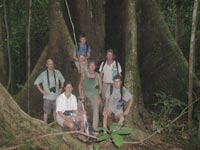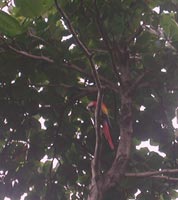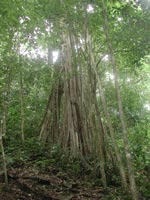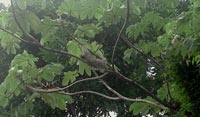HOME |
LOGBOOK |
|
Latitude:
08-32.60N; Longitude: 083-17.90W For this reason we will pay the big bucks to stash the boat in a slip at Banana Bay Marina. Banana Bay is small but top drawer (service-wise) little marina that mostly draws the sportfishing and power boat fleet, and there is an armed guard on duty at night. There are about four sailboats tucked in among the big boys. We didn't hang in at Golfito more than the day as it was hot and muggy and we didn't care to tempt the thieves with the boat at anchor. Besides we'll be seeing plenty of Golfito later. Instead we hightailed it across the Gulfo Dulce to Puerto Jimenez, the main community on the Osa peninsula. The Osa Peninsula is one of the primary centers of Costa Rica's famous ecotourism. Here remains relatively untrammeled tropical rainforest, most of which is at least officially protected by the Corcorvado National Park, although illegal logging and gold mining do take place behind the backs of the limited park ranger force. This
part of the peninsula, however, is not exac n the whole we've been pretty laid back during our week here. We made a dinghy excursion up a river with Dave and Kay in hopes of birds and other wildlife; mostly it was a chatfest, which seems the inevitable product when cruising crews come together. We four also had an excursion to Rincon, a dot on the map at the innermost end of the gulf where the Wave Dancers thought there was a working gold mine to see. Evidently it's elsewhere, but we had a most delightful lunch with our taxi driver at a charming restaurant overlooking the water. We also had a fine meal of Continental cooking at Crocodile Bay, making a welcome change from the local cuisine which centers around rice and beans at all times of the day. However the big event of our stay was our all day hike to Cabo Matapalo. We 2Cs (the Wave Dancers opted out) taxied south of Puerto Jimenez to the tip of the peninsula with our guide Pedro and a super nice Dutch family of four. The Cabo Matapalo area is an interesting mix of wilderness/eco-resorts, private land perserves, and surfer camps in amongst strips of virgin rainforest! One whole chunk of land belongs to a group of Americans from the San Diego area, who keep vacation homes here. We were a little surprised to start our "rainforest hike" walking down roads (albeit rugged 4WD type roads) amongst little home plots, and wondered at the local reaction to rich gringos taking over the land. Pedro, however, made it clear that this enclave was the best thing to have happened, rescuing land that was, or would have been, cleared for farming and allowing it to return to its natural state! The Americans, he said, made the locals wake up to the value of what they had! In addition these secondary growth woods consist of trees whose fruits especially appeal to various wildlife. Rather
than wear you out with a foot by foot account of the many miles
we covered between 6am and 3pm in both the secondary and primary
forests, let me sum up and say we saw everything we'd hoped to see
and more: BIRDS -- dozens of the brilliant scarlet macaws, more
awesome than we'd imagined, feeding in an almond grove just inland
fr (Although we contracted our hike through the well know Escondido Treks Tour agency, our guide Pedro can be contacted direct at an even more reasonable rate through his girlfriend's hair salon "Alexandra" on the corner to the right of Restaurant Carolina.) So
now it's off to Golfito, to strip and store TII for two months rest
while we fly off and gallivant coast to coast in the US, one highlight
of which will be the wedding of Judy Knape (chef on Whisper for
two years and Captain of TII for one) to Bryan ????, of the currently
active VI charteryacht Ursa Minor. We'll be back aboard in mid October.
Until then, fair winds.
|
|
home
| waypoints | logbook | reference shelf
|

 We
cleared out of Panama at Puerto Armuelles and into Costa Rica at
Golfito. Both these ports were built to service the once extensive
banana industry in this part of the world for the huge United Fruit
Company (aka Chiquita). Puerto Armuelles was a pleasant if relatively
simple town with a huge pier reaching out to deep water. Golfito,
on the other hand appears to have once been more sophisticated.
United Fruit built everything there without any money from the government,
reminiscent of the way the US built the Canal Zone. Ironically,
Puerto Armuelles is still functioning while Golfito has been shut
down as a banana port. Banana diseases and the falling banana market
started the trouble, but it was capped off by labor unrest. United
Fruit just shut down and went elsewhere, leaving the town not just
with economic troubles but that chip on their shoulder that goes
along with it! Although Golfito is where we will be storing Tackless
for the two months we are in the States, we are doing so not without
some trepidation. Golfito has a bad reputation for theft! They say
thieves will sneak out to anchored boats during rainstorms while
the owners tipple away in the bar!
We
cleared out of Panama at Puerto Armuelles and into Costa Rica at
Golfito. Both these ports were built to service the once extensive
banana industry in this part of the world for the huge United Fruit
Company (aka Chiquita). Puerto Armuelles was a pleasant if relatively
simple town with a huge pier reaching out to deep water. Golfito,
on the other hand appears to have once been more sophisticated.
United Fruit built everything there without any money from the government,
reminiscent of the way the US built the Canal Zone. Ironically,
Puerto Armuelles is still functioning while Golfito has been shut
down as a banana port. Banana diseases and the falling banana market
started the trouble, but it was capped off by labor unrest. United
Fruit just shut down and went elsewhere, leaving the town not just
with economic troubles but that chip on their shoulder that goes
along with it! Although Golfito is where we will be storing Tackless
for the two months we are in the States, we are doing so not without
some trepidation. Golfito has a bad reputation for theft! They say
thieves will sneak out to anchored boats during rainstorms while
the owners tipple away in the bar! tly
pure wilderness. There is plenty of cattle ranching here like we
saw in Western Panama, and a busy little town full of American and
European tourists. In addition to ecotourist activities like hiking,
camping, and kayaking, there's a surfer community an
tly
pure wilderness. There is plenty of cattle ranching here like we
saw in Western Panama, and a busy little town full of American and
European tourists. In addition to ecotourist activities like hiking,
camping, and kayaking, there's a surfer community an d
a high-end sportfishing biz. We anchored to the SE of the town here
off a fancy new dock belonging to Crocodile Bay Resort (
d
a high-end sportfishing biz. We anchored to the SE of the town here
off a fancy new dock belonging to Crocodile Bay Resort ( om
a wild surfer beach. These endangered birds topped a list that also
included several chestnut mandibled toucans, a hawk, and a trogon.
MONKEYS-- multiple sightings of all four monkey species - howler,
squirrel, spider and white-faced. Imagine walking through rain forest
with groups of wild spider monkeys swinging blithely through the
branches overhead or standing centered below a family of slow-moving
howler monkeys making very satisfactory monkey noises in response
to your guide! OTHER: two sloths (each in a super slow motion sprawl
on a limb); a coati (a large elongated relative of the racoon),
an agouti (like a giant guinea pig), several pygmy squirrels, two
poison arrow frogs, dozens of anoles, a brown snake, a blue-clawed
fresh water crayfish, dozens of butterflies, and a couple of helicopter-flys
(I kid you not...wild!) We were shown more plant and tree species
(along with their medicinal virtues) than I have any hope of ever
recollecting! Most memorable was surely the Matapalo tree, a member
of the ficus family that strangles other trees by encircling it
with a kind of multi-lobed trunk! We also took a snapshot at a Cieba
tree reputed to be one of the largest in Central America! When I
compare it to all the hikes we did in Trinidad where there
om
a wild surfer beach. These endangered birds topped a list that also
included several chestnut mandibled toucans, a hawk, and a trogon.
MONKEYS-- multiple sightings of all four monkey species - howler,
squirrel, spider and white-faced. Imagine walking through rain forest
with groups of wild spider monkeys swinging blithely through the
branches overhead or standing centered below a family of slow-moving
howler monkeys making very satisfactory monkey noises in response
to your guide! OTHER: two sloths (each in a super slow motion sprawl
on a limb); a coati (a large elongated relative of the racoon),
an agouti (like a giant guinea pig), several pygmy squirrels, two
poison arrow frogs, dozens of anoles, a brown snake, a blue-clawed
fresh water crayfish, dozens of butterflies, and a couple of helicopter-flys
(I kid you not...wild!) We were shown more plant and tree species
(along with their medicinal virtues) than I have any hope of ever
recollecting! Most memorable was surely the Matapalo tree, a member
of the ficus family that strangles other trees by encircling it
with a kind of multi-lobed trunk! We also took a snapshot at a Cieba
tree reputed to be one of the largest in Central America! When I
compare it to all the hikes we did in Trinidad where there was hardly any reward in the animal life department, this is so
amazing. All in one day. Way, way way cool!
was hardly any reward in the animal life department, this is so
amazing. All in one day. Way, way way cool!
